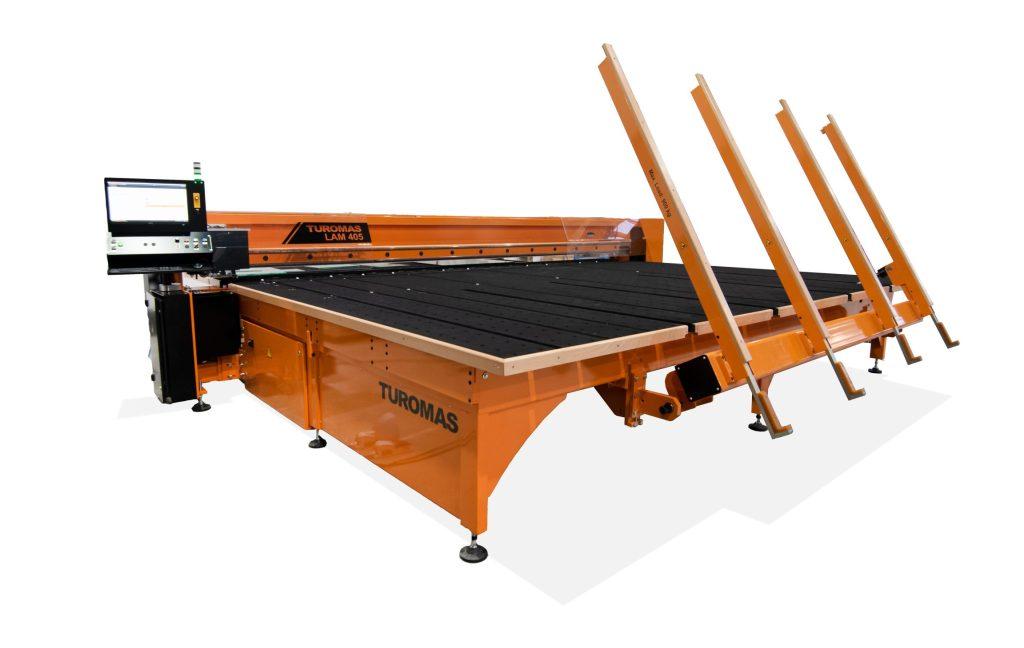LAMINATED GLASS CUTTING MACHINERY
The LAM 100 SERIES has a semi-automatic and autonomous operation. Very easy to operate, it is aimed at companies with an average production requirement of laminated glass up to 8 + 8 mm.
Maximum cut: 3700 mm (146″)
Glass thickness: 8+8 mm (0,31″+0,31″)
The LAM 300 series is aimed at companies looking for a versatile machine with very high cutting quality and performance. Compactly designed, the table can work together with a RUBI monolithic glass cutting table to obtain an efficient mixed cutting line.
Maximum cut: 3700 mm (146″)
Glass thickness: 10+10 mm (0.39″+0.39″)
The LAM 500 series is aimed at companies that require maximum productivity and automation. Designed to work integrated in a cutting line for laminated glass or as part of a mixed line.
Maximum cut:
3700 mm (146″)
4700 mm (185″)
6000 mm (236″)
Glass thickness: 12+12 mm (0.47″+0.47″)
COMMON FEATURES
Extremely robust structural design
Diseño compacto y optimizado. Las mesas ce corte se ensamblan en un todo para ganar en robustez y evitar tensiones que comprometan su funcionamiento. Su diseño mecánico permite absorber las vibraciones producidas por las altas aceleraciones y velocidades, optimizando así la calidad y precisión del corte.
Optimised air cushion
This system allows the glass to be moved manually along the cutting table by means of an improved flotation system. A fan generates a large flow of air which is blown to the surface of the table through adjustable orifices which are evenly distributed.
Cutting and separating system
The upper layer of the glass is cut by an upwardly moving blade that strikes the glass on its underside.
The lower layer is cut by the upper tool, which has an integrated wheel that descends and moves along the upper side of the glass. The butyral is heated by an infrared lamp at the same time as one wheel holds the glass at the bottom and the other stretches in the opposite direction. In this way, as the butyral softens, the glass separates. Finally, the butyral is cut with a blade from the upper tool.
Aluminium board
Our innovative use of aluminium table tops minimises air cushion losses. But the highlight is its combination with the TFS system to guarantee the perfect planimetry of the glass cutting table over time.
Automatic cutting pressure regulation
The control software recognises the type of glass and assigns the optimum pressure for cutting. The pressure can be adjusted according to the speed to always cut at the highest quality, aided by a constantly lubricated electronic valve for the roller.
Mechanical positioning system
The table surface has several grooves through which two stops move to position glass of different lengths. When activated, they move horizontally to position themselves according to the size of the piece to be cut. They then move upwards so that the user can position the workpiece by making contact with them. If the workpiece is small, the front stops will be used, and if the workpiece is large, the rear stops will be used.
Float glass cutting
The LAM range offers the possibility of cutting and cutting float glass. The cutting is carried out by the upper tool and the lower blade carries out the cutting.
Sequential menu of operations
With this interface function, you can choose which specific action you want to carry out on the glass. In other words, in those cases where you do not want to complete the whole sequence (cutting + cutting + separation), you can select which part of the process you want to carry out, for example, heating the butyral, cutting the glass, etc.
Laser positioning aid
The laser beam runs along the entire length of the bridge and serves as a reference for positioning the glass manually. This makes it possible to position the blade at an angle and cut straight workpieces.



